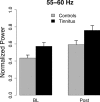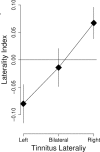The neural code of auditory phantom perception
- PMID: 17287523
- PMCID: PMC6673575
- DOI: 10.1523/JNEUROSCI.3711-06.2007
The neural code of auditory phantom perception
Abstract
Tinnitus is defined by an auditory perception in the absence of an external source of sound. This condition provides the distinctive possibility of extracting neural coding of perceptual representation. Previously, we had established that tinnitus is characterized by enhanced magnetic slow-wave activity (approximately 4 Hz) in perisylvian or putatively auditory regions. Because of works linking high-frequency oscillations to conscious sensory perception and positive symptoms in a variety of disorders, we examined gamma band activity during brief periods of marked enhancement of slow-wave activity. These periods were extracted from 5 min of resting spontaneous magnetoencephalography activity in 26 tinnitus and 21 control subjects. Results revealed the following, particularly within a frequency range of 50-60 Hz: (1) Both groups showed significant increases in gamma band activity after onset of slow waves. (2) Gamma is more prominent in tinnitus subjects than in controls. (3) Activity at approximately 55 Hz determines the laterality of the tinnitus perception. Based on present and previous results, we have concluded that cochlear damage, or similar types of deafferentation from peripheral input, triggers reorganization in the central auditory system. This produces permanent alterations in the ongoing oscillatory dynamics at the higher layers of the auditory hierarchical stream. The change results in enhanced slow-wave activity reflecting altered corticothalamic and corticolimbic interplay. Such enhancement facilitates and sustains gamma activity as a neural code of phantom perception, in this case auditory.
Figures





Similar articles
-
Effects of lifetime noise exposure on the middle-age human auditory brainstem response, tinnitus and speech-in-noise intelligibility.Hear Res. 2018 Aug;365:36-48. doi: 10.1016/j.heares.2018.06.003. Epub 2018 Jun 12. Hear Res. 2018. PMID: 29913342
-
Neuromagnetic indicators of tinnitus and tinnitus masking in patients with and without hearing loss.J Assoc Res Otolaryngol. 2012 Oct;13(5):715-31. doi: 10.1007/s10162-012-0340-5. Epub 2012 Jul 12. J Assoc Res Otolaryngol. 2012. PMID: 22791191 Free PMC article.
-
The absence of resting-state high-gamma cross-frequency coupling in patients with tinnitus.Hear Res. 2017 Dec;356:63-73. doi: 10.1016/j.heares.2017.10.008. Epub 2017 Oct 31. Hear Res. 2017. PMID: 29097049
-
Auditory sensori-neural alterations induced by salicylate.Prog Neurobiol. 2000 Dec;62(6):583-631. doi: 10.1016/s0301-0082(00)00027-7. Prog Neurobiol. 2000. PMID: 10880852 Review.
-
[The cochlea: modern physiologic insights into sensorineural hearing loss].Ned Tijdschr Geneeskd. 1998 Apr 11;142(15):830-6. Ned Tijdschr Geneeskd. 1998. PMID: 9623155 Review. Dutch.
Cited by
-
Maladaptive neural synchrony in tinnitus: origin and restoration.Front Neurol. 2015 Feb 17;6:29. doi: 10.3389/fneur.2015.00029. eCollection 2015. Front Neurol. 2015. PMID: 25741316 Free PMC article. Review.
-
Psychoacoustic tinnitus loudness and tinnitus-related distress show different associations with oscillatory brain activity.PLoS One. 2013;8(1):e53180. doi: 10.1371/journal.pone.0053180. Epub 2013 Jan 10. PLoS One. 2013. PMID: 23326394 Free PMC article.
-
rTMS induced tinnitus relief is related to an increase in auditory cortical alpha activity.PLoS One. 2013;8(2):e55557. doi: 10.1371/journal.pone.0055557. Epub 2013 Feb 4. PLoS One. 2013. PMID: 23390539 Free PMC article.
-
Temporo-insular enhancement of EEG low and high frequencies in patients with chronic tinnitus. QEEG study of chronic tinnitus patients.BMC Neurosci. 2010 Mar 24;11:40. doi: 10.1186/1471-2202-11-40. BMC Neurosci. 2010. PMID: 20334674 Free PMC article.
-
Human Auditory Cortex Neurochemistry Reflects the Presence and Severity of Tinnitus.J Neurosci. 2015 Nov 4;35(44):14822-8. doi: 10.1523/JNEUROSCI.2695-15.2015. J Neurosci. 2015. PMID: 26538652 Free PMC article.
References
-
- Berg P, Scherg M. A multiple source approach to the correction of eye artifacts. Electroencephalogr Clin Neurophysiol. 1994;90:229–241. - PubMed
-
- Calford MB, Rajan R, Irvine DR. Rapid changes in the frequency tuning of neurons in cat auditory cortex resulting from pure-tone-induced temporary threshold shift. Neuroscience. 1993;55:953–964. - PubMed
-
- Delorme A, Makeig S. EEGLAB: an open source toolbox for analysis of single-trial EEG dynamics including independent component analysis. J Neurosci Methods. 2004;134:9–21. - PubMed
-
- Eggermont JJ, Roberts LE. The neuroscience of tinnitus. Trends Neurosci. 2004;27:676–682. - PubMed
Publication types
MeSH terms
LinkOut - more resources
Full Text Sources
Other Literature Sources
Medical
